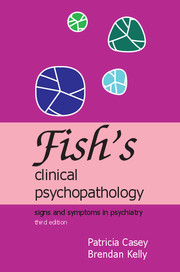Book contents
- Frontmatter
- Contents
- The authors
- Preface
- 1 Classification of psychiatric disorders
- 2 Disorders of perception
- 3 Disorders of thought and speech
- 4 Disorders of memory
- 5 Disorders of emotion
- 6 Disorders of the experience of self
- 7 Disorders of consciousness
- 8 Motor disorders
- 9 Personality disorders
- Appendix I Psychiatric syndromes
- Appendix II Defences and distortions
- Index
7 - Disorders of consciousness
Published online by Cambridge University Press: 15 February 2018
- Frontmatter
- Contents
- The authors
- Preface
- 1 Classification of psychiatric disorders
- 2 Disorders of perception
- 3 Disorders of thought and speech
- 4 Disorders of memory
- 5 Disorders of emotion
- 6 Disorders of the experience of self
- 7 Disorders of consciousness
- 8 Motor disorders
- 9 Personality disorders
- Appendix I Psychiatric syndromes
- Appendix II Defences and distortions
- Index
Summary
Recent decades have seen a considerable renaissance of scientific interest in the study of human consciousness in general (Edelman, 1989; Dennett, 1991; Damasio, 2000). For the purposes of descriptive clinical psychopathology, consciousness can be simply defined as a state of awareness of the self and the environment. In the fully awake subject the intensity of consciousness varies considerably. If someone is carrying out a difficult experiment their level of consciousness will be at its height, but when they are sitting in an armchair glancing though the newspaper the intensity of their consciousness will be much less. In fact, when subjects are monitoring a monotonously repetitive set of signals, short periods of sleep may occur between signals and are not recognised by the subject, but are shown clearly by changes in the electroencephalogram (EEG).
Before we can discuss the disorders of consciousness we must deal with the possibly confounding issue of attention. Attention can be active when the subject focuses their attention on some internal or external event, or passive when the same events attract the subject's attention without any conscious effort on their part. Active and passive attention are reciprocally related to each other, since the more the subject focuses their attention the greater must be the stimulus that will distract them (i.e. bring passive attention into action).
Disturbance of active attention shows itself as distractibility, so that the patient is diverted by almost all new stimuli and habituation to new stimuli takes longer than usual. It can occur in fatigue, anxiety, severe depression, mania, schizophrenia and organic states. In abnormal and morbid anxiety, active attention may be made difficult by anxious preoccupations, while in some organic states and paranoid schizophrenia, distractibility may be the result of a paranoid frame of mind. In other individuals with acute schizophrenia, distraction may be regarded as the result of formal thought disorder because the patient is unable to keep the marginal thoughts (which are connected with external objects by displacement, condensation and symbolism) out of their thinking, so that irrelevant external objects are incorporated into their thinking.
Attention is affected by an individual's mind-set, which, in the absence of mental illness, is generally non-rigid and is altered in response to incoming information.
- Type
- Chapter
- Information
- Fish's Clinical PsychopathologySigns and Symptoms in Psychiatry, pp. 81 - 86Publisher: Royal College of PsychiatristsPrint publication year: 2007



